Study on Two Component Gas Transport in Nanopores for Enhanced Shale Gas Recovery by Using Carbon Dioxide Injection
Abstract
1. Introduction
2. Gas Transport Mechanisms in Shale Inorganic and Organic Nanopores
2.1. Gas Transport Mechanisms in Organic Nanopores
2.1.1. Knudsen Diffusion
2.1.2. Viscous Flow
2.1.3. Surface Diffusion
2.1.4. Molecular Diffusion
2.1.5. Pore Radius Correction
2.2. Gas Transport Mechanism in the Inorganic Nanopores
2.2.1. Knudsen Diffusion
2.2.2. Slip Flow
2.2.3. Molecular Diffusion
2.2.4. Real Gas Effect
2.2.5. Pore Width Correction for Inorganic Nanopores
3. Construction of Apparent Permeability Model for Two-Component Gas
3.1. Mass Flow Equation
3.2. Apparent Permeability for Two-Component Gas
4. Model Validation
5. Results and Analysis
5.1. Pressure (p) and Pore Radius (r)
5.1.1. Effect of p and r on Two-Component Gas Apparent Permeability
5.1.2. Effect of p and r on Permeability Ratio
5.1.3. Contribution of Various Gas Mechanisms with p and r Changing
5.2. Effect of Temperature and Fraction of Organic Nanopores
5.3. Effect of Gas Concentration
6. Conclusions
Author Contributions
Funding
Acknowledgments
Conflicts of Interest
References
- Guo, C.; Liu, H.; Xu, L.; Zhou, Q. An improved transport model of shale gas considering three-phase adsorption mechanism in nanopores. J. Pet. Sci. Eng. 2019, 182, 106291. [Google Scholar] [CrossRef]
- Boyer, C.; Kieschnick, J.; Suarez-Rivera, R. Producing gas from its source. Oilfield Rev. 2006, 18, 36–49. [Google Scholar]
- Jung, C.; Zhou, J.; Chenevert, M.; Sharma, M.M. The impact of shale preservation on the petrophysical properties of organic-rich shales. In Proceedings of the SPE Annual Technical Conference and Exhibition, SEP 20-OCT 2, New Orleans, LA, USA, 30 September–2 October 2013. [Google Scholar]
- Hu, Y.; Devegowda, D.; Striolo, A.; Phan, A.; Ho, T.A.; Civan, F.; Sigal, R.F. Microscopic dynamics of water and hydrocarbon in shale-kerogen pores of potentially mixed-wettability. Paper Presented at SPE Unconventional Resources Conference, Calgary, AB, Canada, 5–7 November 2013. [Google Scholar]
- Li, J.; Li, X.; Wu, K. Thickness and stability of water film confined inside nanoslits and nanocapillaries of shale and clay. Int. J. Coal Geol. 2017, 179, 253–268. [Google Scholar] [CrossRef]
- Korb, J.; Nicot, B.; Louis-Joseph, A. Dynamics and wettability of oil and water in oil shales. J. Phys. Chem. C 2014, 118, 23212–23218. [Google Scholar] [CrossRef]
- Jin, Z.; Firoozabadi, A. Effect of water on methane and carbon dioxide sorption in clay minerals by Monte Carlo simulations. Fluid Phase Equilibria 2014, 382, 10–20. [Google Scholar] [CrossRef]
- Wang, Y.; Zhu, Y.; Liu, S. Pore characterization and its impact on methane adsorption capacity for organic-rich marine shales. Fuel 2016, 181, 227–237. [Google Scholar] [CrossRef]
- Wang, J.; Luo, H.; Cao, F. An integrative model to simulate gas transport and production coupled with gas adsorption, non-Darcy flow, surface diffusion, and stress dependence in organic-shale reservoirs. SPE J. 2017, 22, 244–264. [Google Scholar] [CrossRef]
- Feng, Q.; Xu, S.; Wang, S. Apparent permeability model for shale oil with multiple mechanisms. J. Pet. Sci. Eng. 2019, 175, 814–827. [Google Scholar] [CrossRef]
- Song, W.; Yao, J.; Ma, J.; Couples, G.; Li, Y. Assessing relative contributions of transport mechanisms and real gas properties to gas flow in nanoscale organic pores in shales by pore network modelling. Int. J. Heat Mass Transf. 2017, 113, 524–537. [Google Scholar] [CrossRef]
- Cai, J.; Lin, D.; Singh, H.; Zhou, S.; Meng, Q.; Zhang, Q. A simple permeability model for shale gas and key insights on relative importance of various transport mechanisms. Fuel 2019, 252, 210–219. [Google Scholar] [CrossRef]
- Singh, H.; Javadpour, F.; Ettehadtavakkol, A. Nonempirical Apparent Permeability of Shale. SPE Reserv. Eval. Eng. 2014, 17, 414–424. [Google Scholar] [CrossRef]
- Wu, K.; Chen, Z.; Li, X.; Guo, C.; Wei, M. A model for multiple transport mechanisms through nanopores of shale gas reservoirs with real gas effect–adsorption-mechanic coupling. Int. J. Heat Mass Transf. 2016, 93, 408–426. [Google Scholar] [CrossRef]
- Javadpour, F. Nanopores and apparent permeability of gas flow in mudrocks (shales and siltstone). J. Can. Pet. Technol. 2009, 48, 16–21. [Google Scholar] [CrossRef]
- Darabi, H.; Ettenhad, A.; Javadpour, F. Gas flow in ultra-tight shale strata. J. Fluid Mech. 2012, 710, 641–658. [Google Scholar] [CrossRef]
- Zhang, Y.; Li, D.; Sun, X.; Shi, D.; Su, Y. A new model for calculating the apparent permeability of shale gas in the real state. Nat. Gas Ind. B 2018, 5, 245–252. [Google Scholar] [CrossRef]
- Xu, S.; Feng, Q.; Wang, S.; Li, Y. A 3D multi-mechanistic model for predicting shale gas permeability. J. Nat. Gas Sci. Eng. 2019, 68, 102913. [Google Scholar] [CrossRef]
- Li, Z.; Elsworth, D. Controls of CO2–N2 gas flood ratios on enhanced shale gas recovery and ultimate CO2 sequestration. J. Pet. Sci. Eng. 2019, 179, 1037–1045. [Google Scholar] [CrossRef]
- Fathi, E.; Akkutlu, I. Multi-component gas transport and adsorption effects during CO2 injection and enhanced shale gas recovery. Int. J. Coal Geol. 2014, 123, 52–61. [Google Scholar] [CrossRef]
- Kang, S.; Fathi, E.; Ambrose, R.; Akkutlu, I.Y.; Sigal, R.F. Carbon dioxide storage capacity of organic-rich shales. SPE J. 2011, 16, 842–855. [Google Scholar] [CrossRef]
- Sun, H.; Yao, J.; Gao, S.H.; Fan, D.Y.; Wang, C.C.; Sun, Z.X. Numerical study of CO2 enhanced natural gas recovery and sequestration in shale gas reservoirs. Int. J. Greenh. Gas Control 2013, 19, 406–419. [Google Scholar] [CrossRef]
- Afsharpoor, A.; Javadpour, F. Liquid slip flow in a network of shale noncircular nanopores. Fuel 2016, 180, 580–590. [Google Scholar] [CrossRef]
- Ji, L.; Lin, M.; Jiang, W.; Cao, G.; Zhou, J.; Luo, C. Investigation into the apparent permeability and gas-bearing property in typical organic pores in shale rocks. Mar. Pet. Geol. 2019, 110, 871–885. [Google Scholar] [CrossRef]
- Chen, M.; Kang, Y.; Li, X.; Wang, W.; Yang, B.; Liu, H. Investigation of multi-scale gas transport behavior in organic-rich shale. J. Nat. Gas Sci. Eng. 2016, 36, 1188–1198. [Google Scholar] [CrossRef]
- Li, J.; Li, X.; Wang, X.; Li, Y.; Wu, K.; Shi, J.; Yu, P. Water distribution characteristic and effect on methane adsorption capacity in shale clay. Int. J. Coal Geol. 2016, 159, 135–154. [Google Scholar] [CrossRef]
- Aylmore, L.; Quirk, J. The micropore size distributions of clay mineral systems. Eur. J. Soil Sci. 1967, 18, 1–17. [Google Scholar] [CrossRef]
- Javadpour, F.; Fisher, D.; Unsworth, M. Nanoscale gas flow in shale gas Sediments. J. Can. Pet. Technol. 2007, 46, 55–61. [Google Scholar] [CrossRef]
- Florence, F.; Rushing, J.; Newsham, K.; Blasingame, T.A. Improved permeability prediction relations for low permeability sands. Paper Presented at SPE Rocky Mt. Oil Gas Technol. Symp., Denver, CO, USA, 16–18 April 2007. [Google Scholar]
- Wu, K.; Li, X.; Wang, C.; Yu, W.; Chen, Z. Model for surface diffusion of adsorbed gas in nanopores of shale gas reservoirs. Ind. Eng. Chem. Res. 2015, 54, 3225–3236. [Google Scholar] [CrossRef]
- Chen, Y.; Yang, R. Concentration dependence of surface diffusion and zeolitic diffusion. Aiche J. 1991, 37, 1579–1582. [Google Scholar] [CrossRef]
- Wu, K.; Li, X.; Wang, C.; Chen, Z.; Yu, W. A model for gas transport in microfractures of shale and tight gas reservoirs. Aiche J. 2015, 61, 2079–2088. [Google Scholar] [CrossRef]
- Milliken, K.; Rudnicki, M.; Awwiller, D.; Zhang, T. Organic matter-hosted pore system, Marcellus Formation (Devonian), Pennsylvania. AAPG Bull. 2013, 97, 177–200. [Google Scholar] [CrossRef]
- Civan, F.; Rai, C.; Sondergeld, C. Shale-gas permeability and diffusivity inferred by improved formulation of relevant retention and transport mechanisms. Transp. Porous Media 2011, 86, 925–944. [Google Scholar] [CrossRef]
- Song, W.; Yao, J.; Li, Y.; Sun, H.; Zhang, L.; Yang, Y.; Sui, H. Apparent gas permeability in an organic-rich shale reservoir. Fuel 2016, 181, 973–984. [Google Scholar] [CrossRef]
- Wu, K.; Chen, Z.; Li, X.; Xu, J.; Li, J.; Wang, K.; Dong, X. Flow behavior of gas confined in nanoporous shale at high pressure: Real gas effect. Fuel 2017, 205, 173–183. [Google Scholar] [CrossRef]
- Feng, C. Effects of CO2 and CH4 mixture binary gas on permeability of shale. J. Hunan Univ. Sci. Technol. 2017, 32, 1–5. [Google Scholar]
- Erfan, M.; Hassan, H.; Chen, Z. Estimation of shale apparent permeability for multimechanistic, multicomponent gas production using rate transient analysis. Energy Fuels 2019, 33, 1990–1997. [Google Scholar]
- Cussler, E. Diffusion: Mass Fransfer in Fluid Systems, 3rd ed.; Cambridge University Press: Cambridge, UK, 1997; pp. 117–160. [Google Scholar]
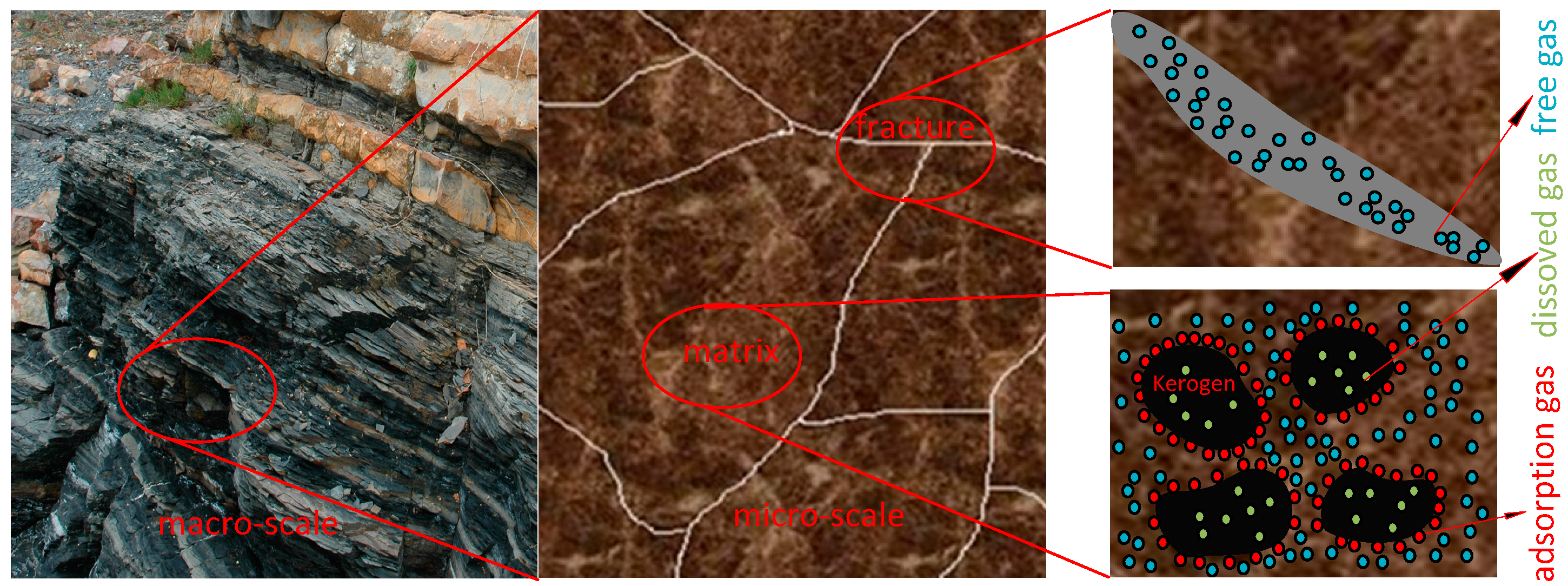

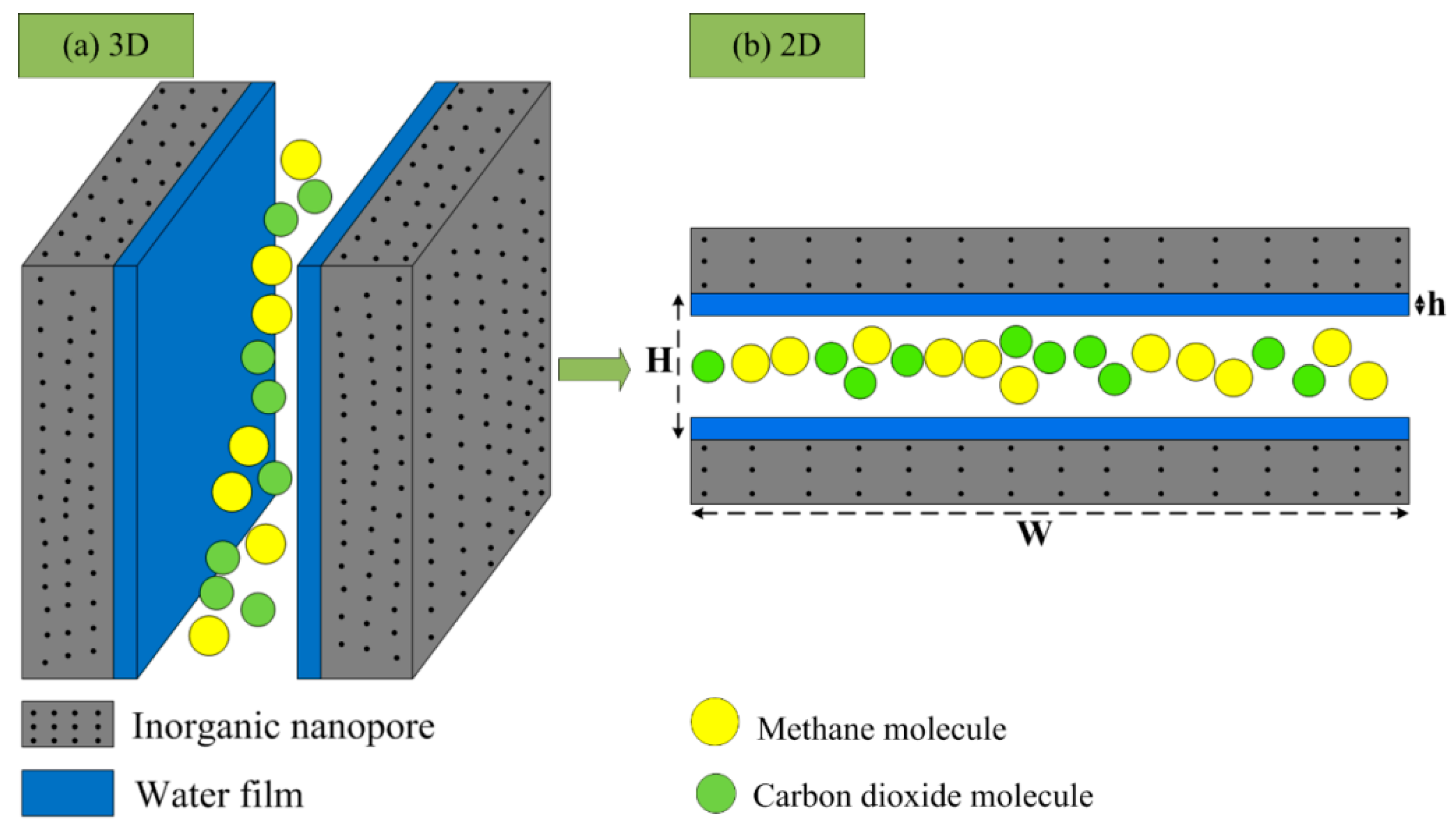
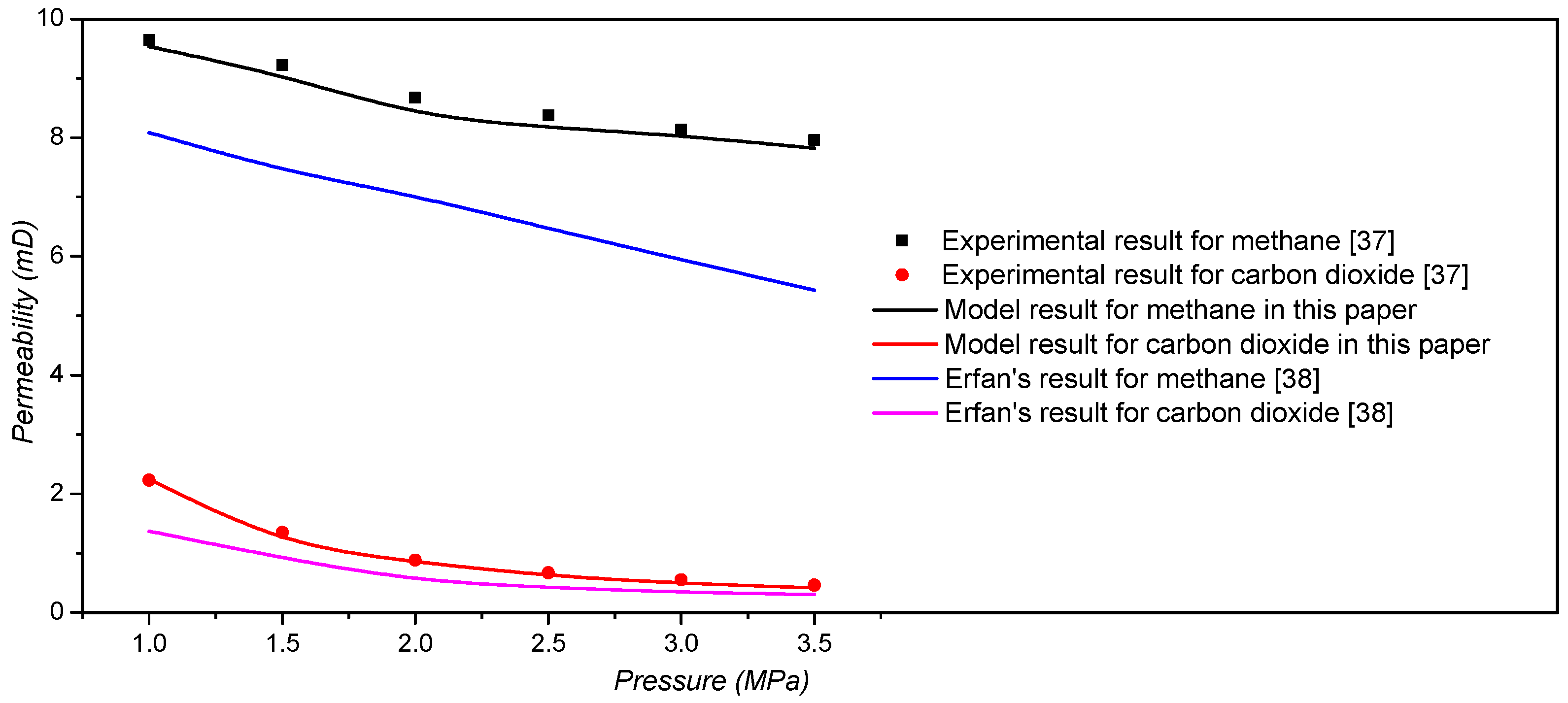

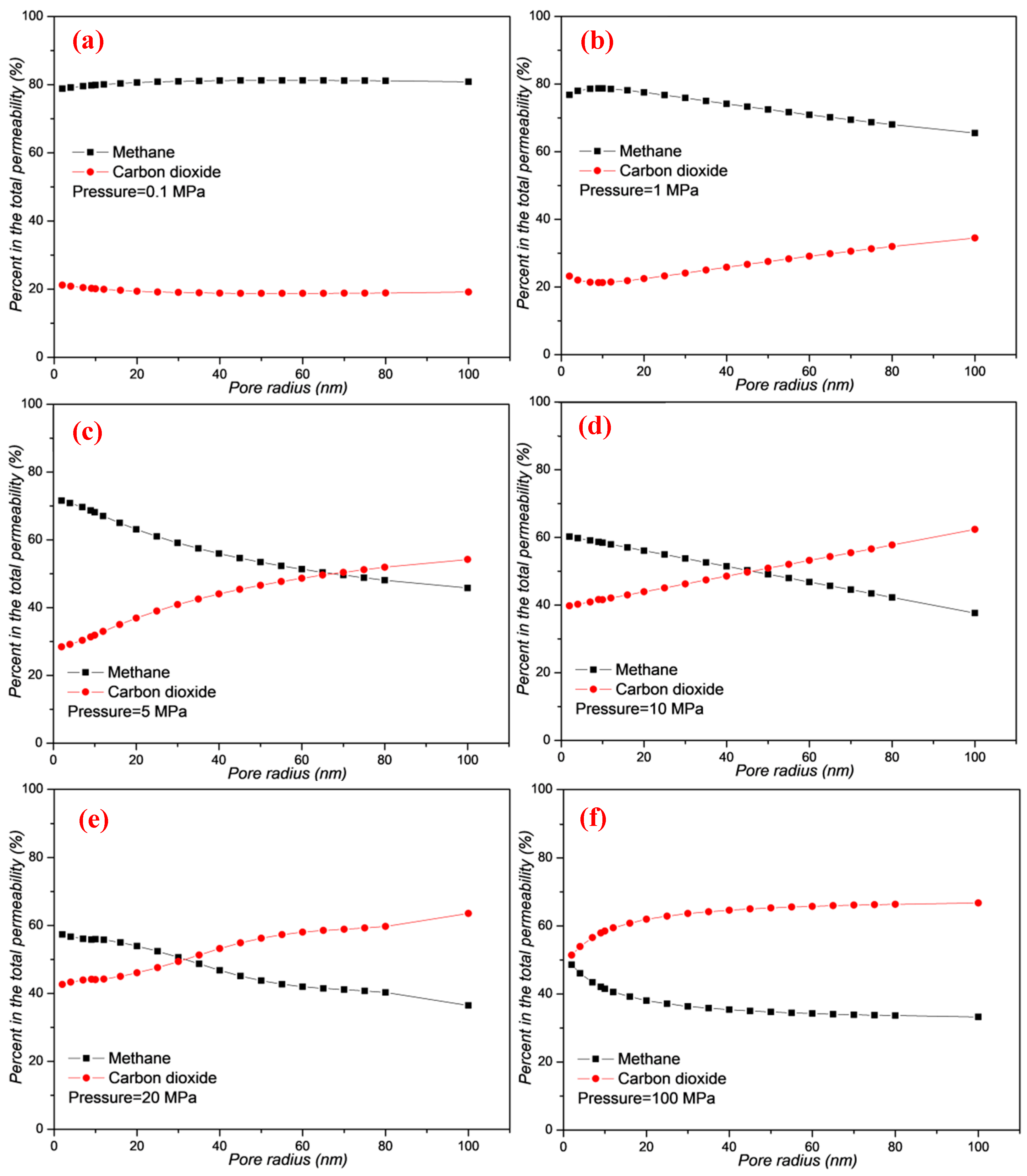

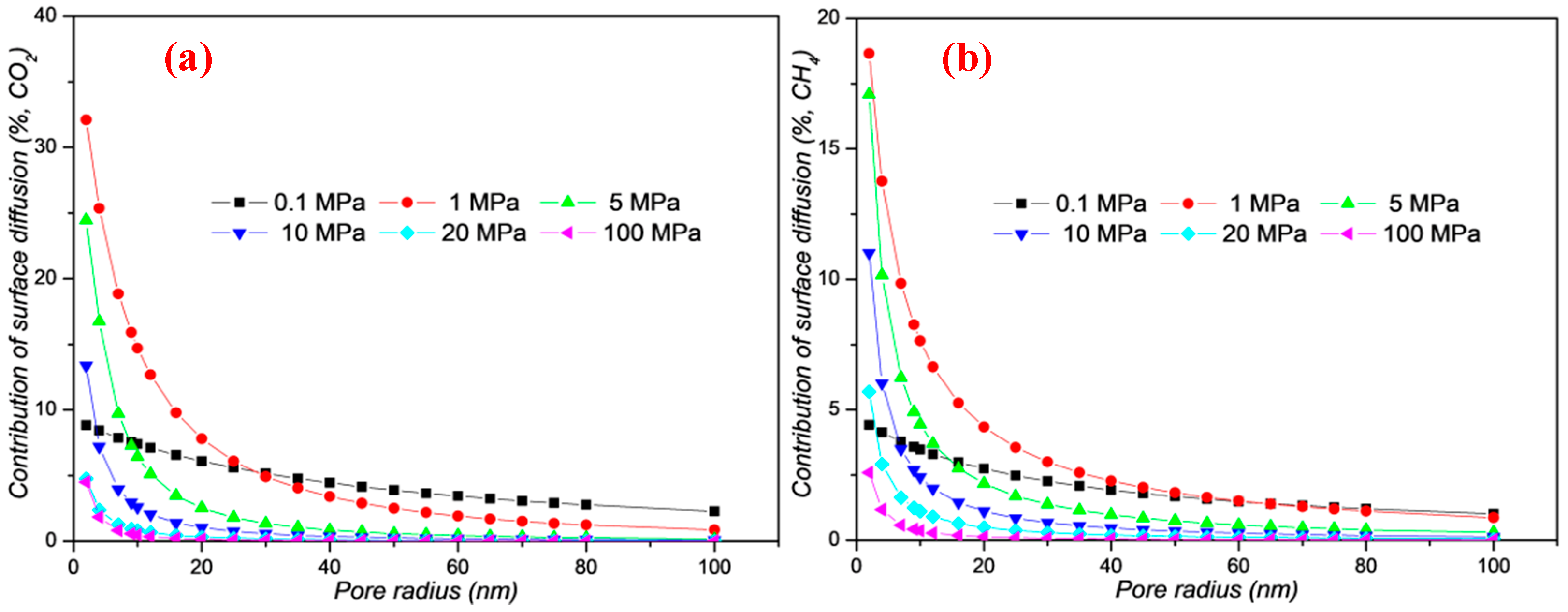
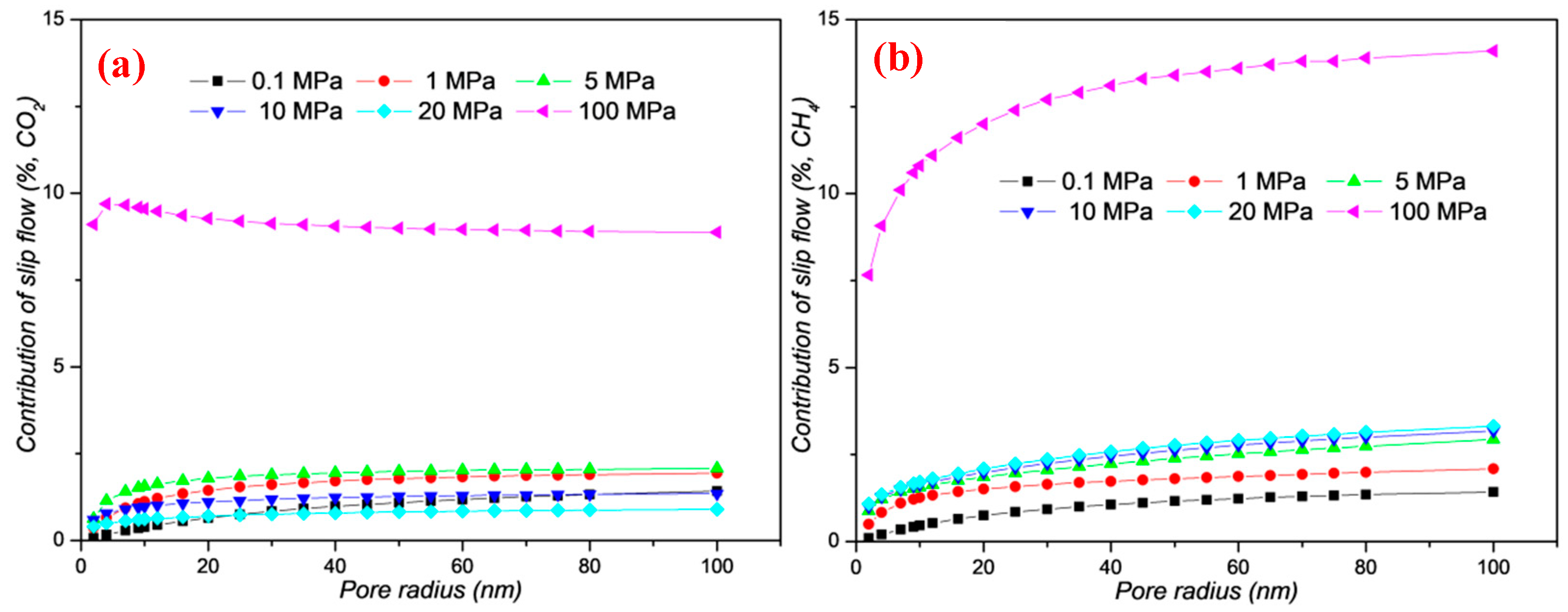
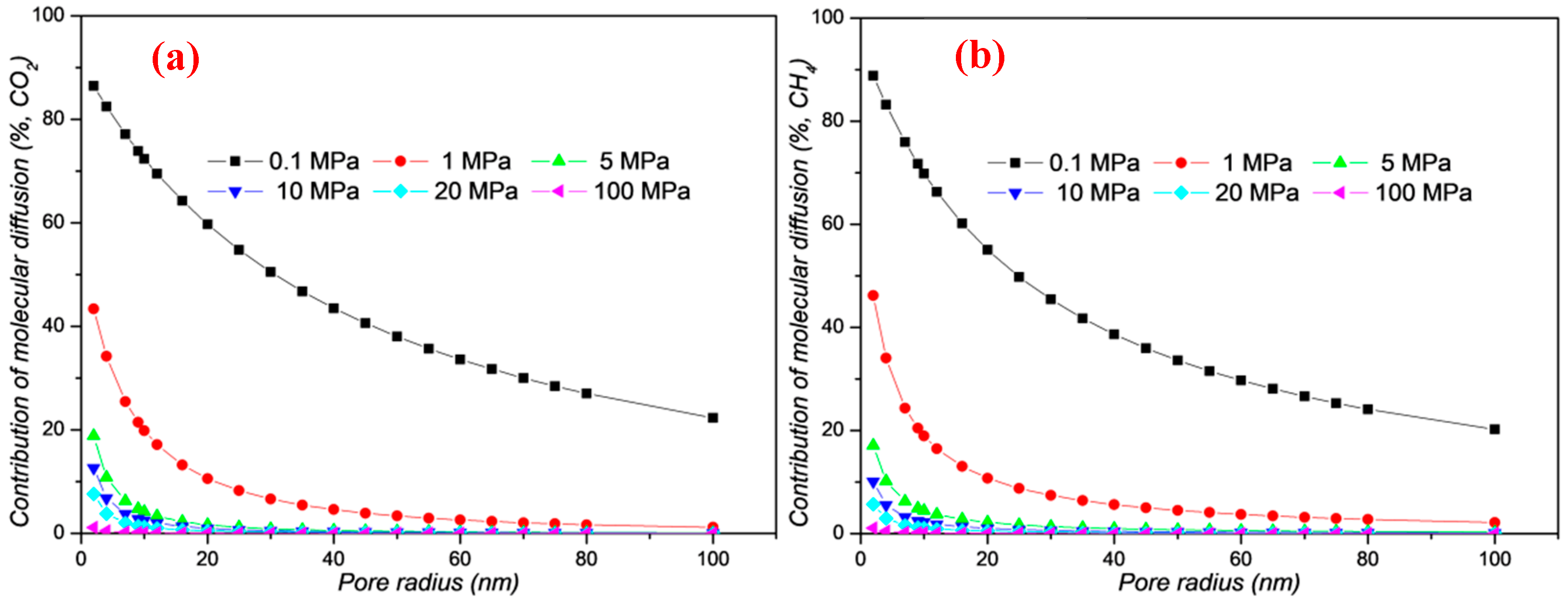

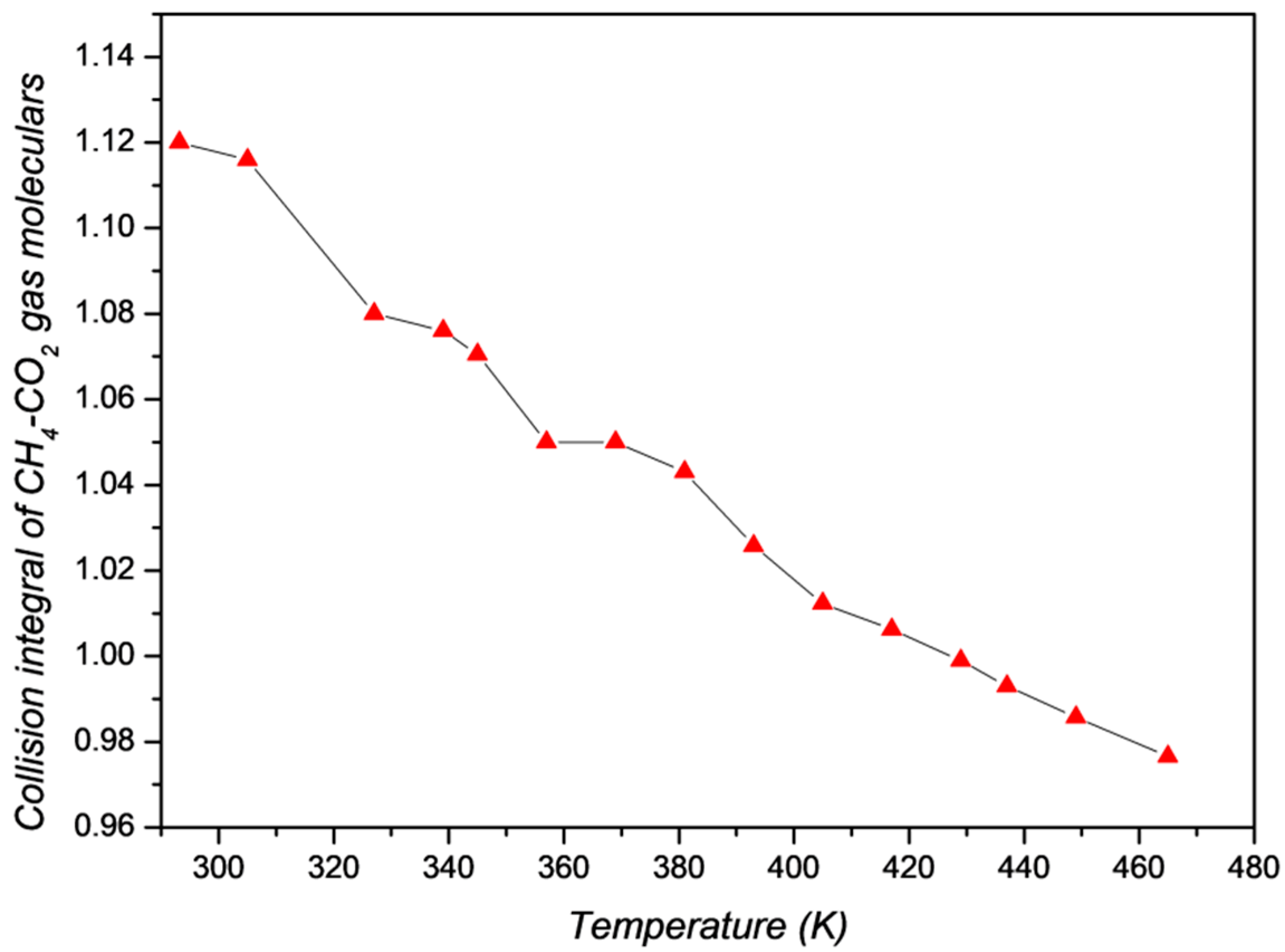
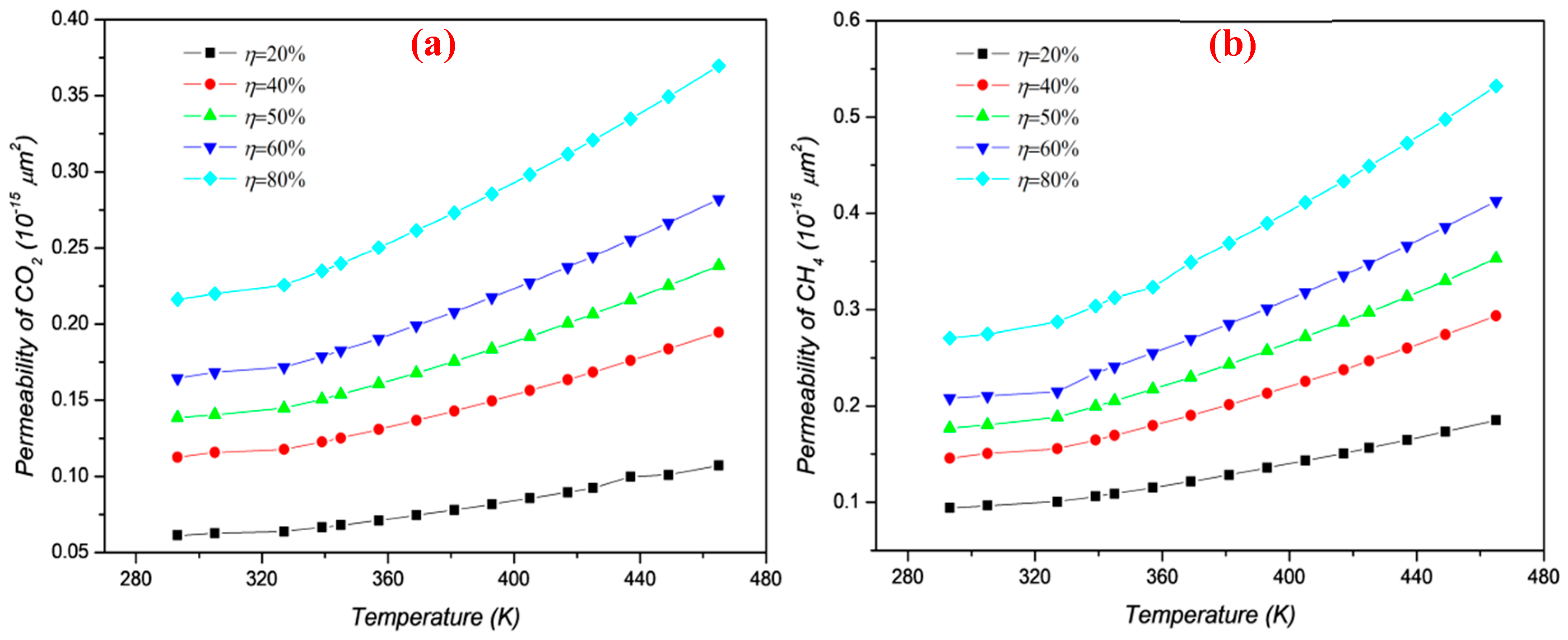
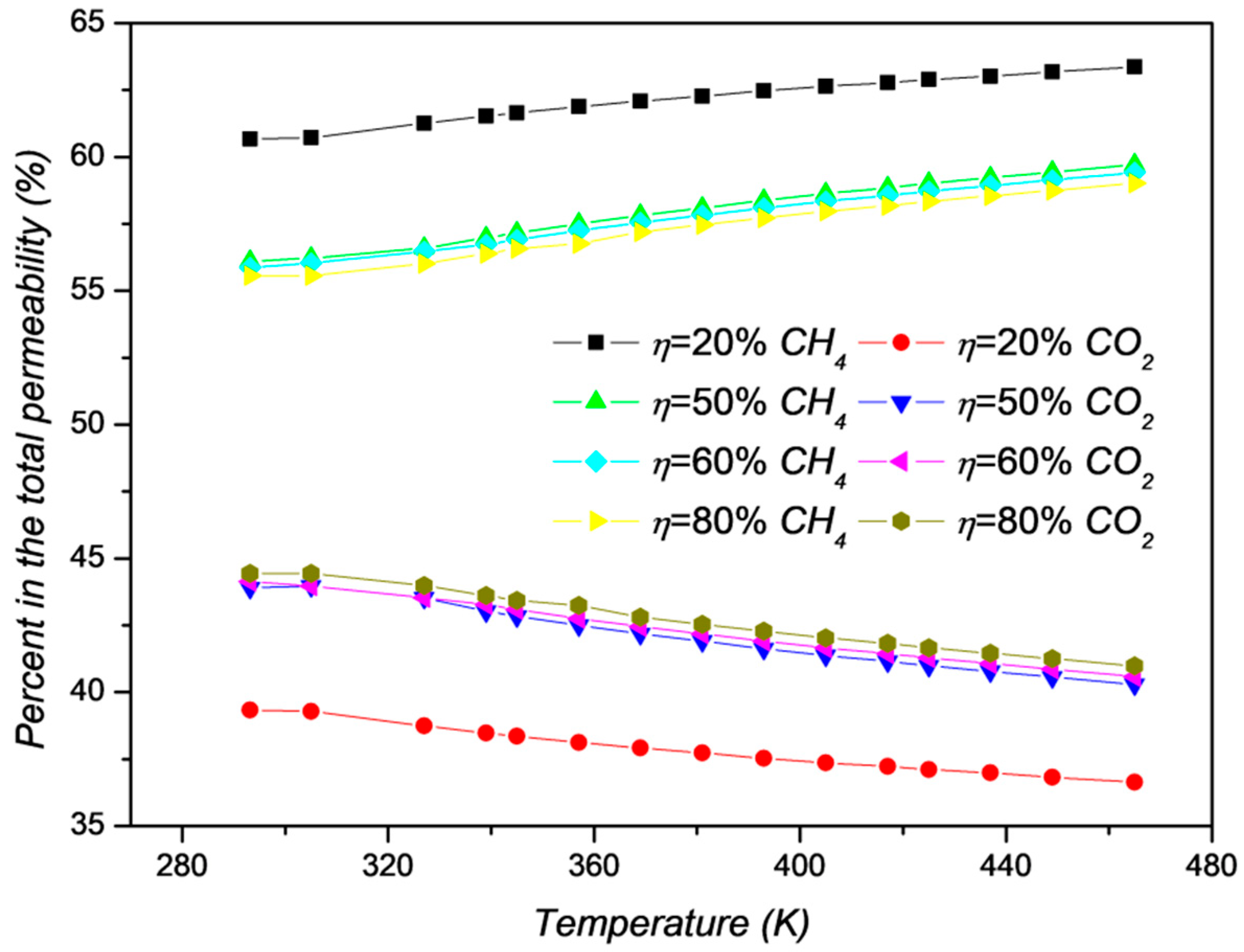

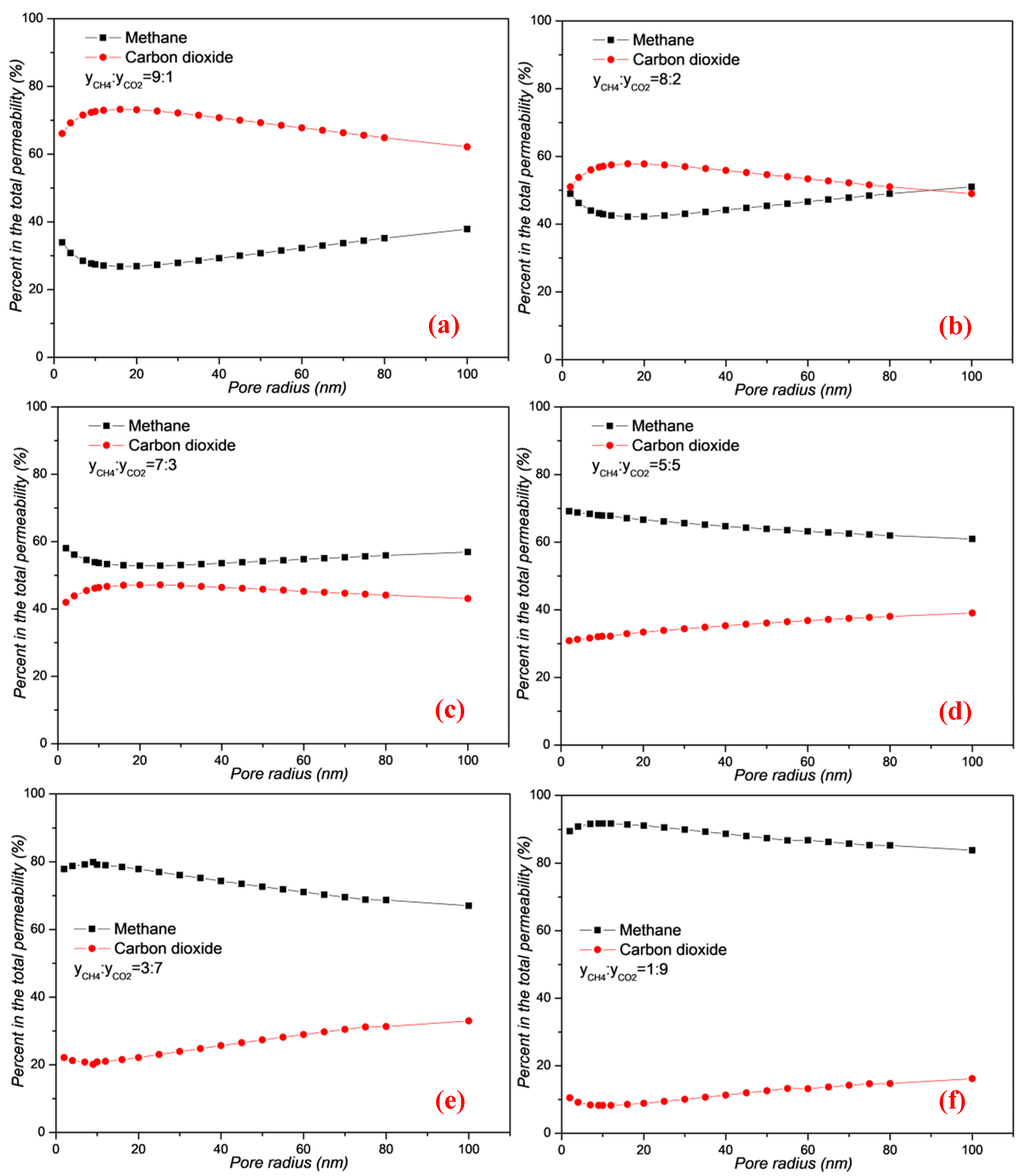
| Parameters | Symbol | Unit | Value |
|---|---|---|---|
| Fraction of organic nanopores | η | decimal | 0.2/0.4/0.5/0.6/0.8 |
| Pressure | p | Pa | (0.1/1/5/10/20/100) × 106 |
| Mole fraction of CO2 | yCO2 | decimal | 0.9/0.7/0.5/0.3/0.2/0.1 |
| Mole fraction of CH4 | yCH4 | decimal | 0.1/0.3/0.5/0.7/0.8/0.9 |
| Universal gas constant | R | J/mol·K | 8.314 |
| Temperature | T | K | 293.15–465 |
| Molar mass of CO2 | MCO2 | kg/mol | 0.044 |
| Molar mass of CH4 | MCH4 | kg/mol | 0.016 |
| Pore radius of organic nanopore | r | m | (2–100) × 10−9 |
| Equal adsorption heat | J/mol | 16,000 | |
| Surface gas molecular blocking coefficient | dimensionless | 0.5 | |
| Avogadro constant | NA | 1/mol | 6.022 × 1023 |
| Langmuir pressure of CO2 | PL(CO2) | Pa | 1.38 × 106 |
| Langmuir pressure of CH4 | PL(CH4) | pa | 2.07 × 106 |
| Langmuir volume of CO2 | VL(CO2) | m3/kg | 0.0477 |
| Langmuir volume of CH4 | VL(CH4) | m3/kg | 0.0256 |
| Lennard–Jones potential collision diameter of CH4 molecule | 3.758 | ||
| Lennard–Jones potential collision diameter of CO2 molecule | 3.941 | ||
| Compression | dimensionless | 1 | |
| Shape factor of the flat shape model | ζ | dimensionless | 4 |
| Nanopore shape fractor with rectangular cross-section in Knudsen diffusion | B(ζ) | dimensionless | 10.641 |
| Nanopore shape factor with rectangular cross-section in slip flow | A(ζ) | dimensionless | 1.372 |
| Porosity | Φ | decimal | 0.05 |
| Curvature | τ | dimensionless | 4.3 |
| Fractal dimension of the nanopore | Df | dimensionless | 2.653 |
| Thickness of water film | h | m | 0.2 × 10−9 |
| Gas sparse coefficient of CH4 | dimensionless | 1.13 | |
| Gas sparse coefficient of CO2 | dimensionless | 1.25 | |
| Width of inorganic nanopore | H | m | (2–100) × 10−9 |
© 2020 by the authors. Licensee MDPI, Basel, Switzerland. This article is an open access article distributed under the terms and conditions of the Creative Commons Attribution (CC BY) license (http://creativecommons.org/licenses/by/4.0/).
Share and Cite
Guo, C.; Li, R.; Wang, X.; Liu, H. Study on Two Component Gas Transport in Nanopores for Enhanced Shale Gas Recovery by Using Carbon Dioxide Injection. Energies 2020, 13, 1101. https://doi.org/10.3390/en13051101
Guo C, Li R, Wang X, Liu H. Study on Two Component Gas Transport in Nanopores for Enhanced Shale Gas Recovery by Using Carbon Dioxide Injection. Energies. 2020; 13(5):1101. https://doi.org/10.3390/en13051101
Chicago/Turabian StyleGuo, Chaohua, Rongji Li, Xin Wang, and Hongji Liu. 2020. "Study on Two Component Gas Transport in Nanopores for Enhanced Shale Gas Recovery by Using Carbon Dioxide Injection" Energies 13, no. 5: 1101. https://doi.org/10.3390/en13051101
APA StyleGuo, C., Li, R., Wang, X., & Liu, H. (2020). Study on Two Component Gas Transport in Nanopores for Enhanced Shale Gas Recovery by Using Carbon Dioxide Injection. Energies, 13(5), 1101. https://doi.org/10.3390/en13051101





